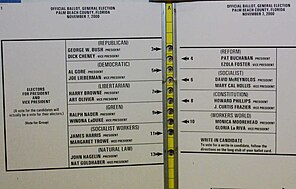Election science
| Part of the Politics series |
| Politics |
|---|
|
|
Election science is a field that deals with the conduct and administration of

The study of election science can be traced back to early scientific studies of electoral systems and particularly the development of the field of social choice theory, including the Marquis de Condorcet's analysis of electoral systems in the 18th century. The field came into being following the 2000 United States presidential election,[1] where several administrative[2] and technical failures[3] may have affected the outcome of the election. Examples of subjects where election science methods are applied include gerrymandering, electoral fraud, suffrage, and voter registration.
There is an academic conference[4] dedicated to the study of election science and the Southern Political Science Association has a sub-conference for the study of election science.[5] In addition, multiple universities now offer a bachelor of science in political science for a data science track.[6][7]
The Center for Election Science supports academic research in the fields of election science and social choice theory,[8] as well as making outreach and education efforts towards the broader public.[9]
See also
References
- S2CID 28262658.
- JSTOR 20202391. Retrieved 2023-02-10.
- from the original on November 24, 2016. Retrieved 2023-02-10.
- ^ "Election Science, Reform, and Administration Conference". esra-conference.org. Retrieved 2023-02-10.
- ^ "2023 Election Science Conference-within-a-Conference". Joseph A. Coll. Retrieved 2023-02-10.
- ^ "BS in Data Sciences in Political Science". American University. Retrieved 2023-02-10.
- ^ "Data Science Track | Political Science". politicalscience.stanford.edu. Retrieved 2023-02-10.
- ^ Raleigh, Chris (2024-04-08). "Ranked Choice in NYC: A Look at the Voter Experience with Professor Lindsey Cormack".
- ^ "About Us".
External links
- "Deepening the Field of Election Science". MIT Election & Data Science Lab. Retrieved 2023-02-10.
